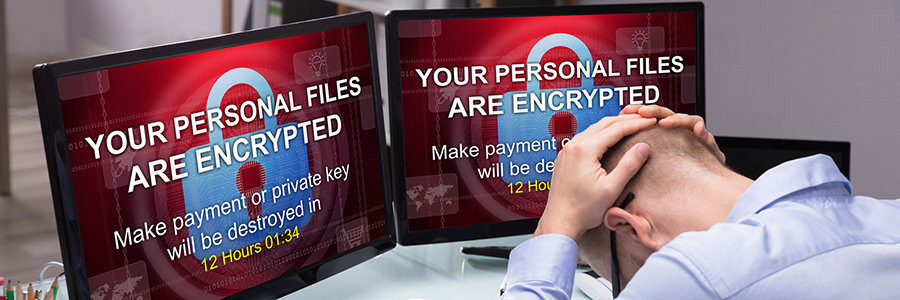Ransomware is a major threat to businesses. In 2023 alone, ransomware attacks have affected 72.7 percent of organizations across the world. IBM’s Cost of a Data Breach Report 2022 disclosed that the average ransom demand was $812, 360, with the average total financial losses for a ransomware victim reaching $4.5 million.
Fortunately, there are ways to protect your systems from ransomware and the cybercriminals who use it.
What is ransomware?
Ransomware is a malicious type of software cybercriminals use to infect computer systems. Once it has infiltrated a system, the ransomware will encrypt important files, rendering them inaccessible or unreadable, then demand a ransom for their restoration. In addition, ransomware can spread to other connected systems, including shared drives and neighboring computers, making it more difficult to contain. If the victim fails to meet the cybercriminal’s demands, usually an enormous sum of money, their data remains locked and useless.
But even when a ransom is paid, there’s no guarantee that the attacker will provide the decryption key or refrain from further extortion. Businesses like hospitals and schools are particularly vulnerable to ransomware because they rely heavily on data. Hospitals, in particular, need to operate at all times for their patients’ health.
10 Cybersecurity tips to protect your data from ransomware
For all that ransomware can threaten your data and your organization, there are steps you can take to minimize the threat it poses. Here are 10 tips to thwart ransomware:
1. Use antivirus software and firewalls
Your primary defense against ransomware will usually consist of antivirus software and firewalls. Firewalls act as the first line of defense against external attacks, filtering and blocking suspicious data before it can enter your system. Antivirus software are programs and protocols that scan for, detect, and respond to cyberthreats in your systems. But be on the lookout for fake virus detection alerts mimicking antivirus software, especially through emails or website pop-ups. Always verify alerts directly through your antivirus software.
2. Update your systems
Keep your antivirus, operating system, software, and web browsers updated to the latest versions. Ransomware, as well as other forms of malware, are continually evolving as cybercriminals redesign them to target the weaknesses in current software.
3. Back up your data
As a way to mitigate the damage of a ransomware attack, backing up your data is simple and effective. The usual preferences for secure storage are external hard drives or well-protected cloud servers, sometimes both. Thanks to regular data backups, you can more easily restore your data and systems after a ransomware attack. Use the 3-2-1 approach, which involves making three separate copies of your data on two different storage types, with one copy stored off site.
4. Secure endpoints
Endpoint refers to any device that connects to your system, making it a target of entry for cyberattackers. Securing your endpoints is vital for expanding businesses with increasing numbers of users and their devices. Implement endpoint protection platforms or endpoint detection and response to secure all of your devices. Administrators can use these technologies to monitor and manage security for remote devices, resulting in more efficient threat response.
5. Application control
Prevent unauthorized applications from running on your systems. This extends to preventing unauthorized websites from downloading their software onto your computers. Use whitelisting software to restrict or block unauthorized programs and websites. Some software can also blacklist, which automatically blocks specific programs and websites according to parameters set by you.
6. Network segmentation
Since ransomware can spread rapidly within a network, incorporating network segmentation is essential. By dividing your network into smaller segments, it becomes easier to isolate and halt the spread of ransomware. Each segment should have its own set of security controls and firewalls to shield vital data from ransomware.
7. Train your staff
Human error has consistently been one of the leading factors behind successful cyberattacks, including ransomware. In the 2023 Thales Data Threat Report, 55% of respondents cited human error as the primary cause behind cloud server data breaches. Most of the time, it is an accident or negligence, but in the worst cases, it can be malicious intent.
Security awareness training can significantly lower the risk of a ransomware attack for your organization. Training can educate your staff on using the internet safely, setting stronger passwords, avoiding public Wi-Fi, updating software regularly, reporting suspicious activity, and recognizing suspicious emails.
8. Beware of phishing attacks
Phishing attacks are often delivered via emails and are a common vector for ransomware infection. Teach your staff to avoid opening emails from unknown senders, as well as clicking on attachments, files, or links from unverified sources. You should also implement email security solutions that can scan, analyze, and flag possibly malicious emails or attachments.
9. Control user access
Often enough, an employee possesses the unwitting potential to enable a ransomware attack. In these circumstances, implementing an access control policy emerges as a viable defense component.
Maintain as standard practice a policy that only grants access to individuals who genuinely require it. You should consider adopting the practice of least privilege, wherein you equip employees with the minimum necessary access levels according to their roles.
10. Test your security constantly
All the defensive measures, training, and preparation can be for naught without regular cybersecurity tests and assessments. These tests are essential and highly effective at identifying system vulnerabilities. By revealing the weak points in your security systems and protocols, you get a better understanding of what needs to be updated and corrected.
Learn more about protecting your systems and data from ransomware by reaching out to a predictiveIT expert today.


